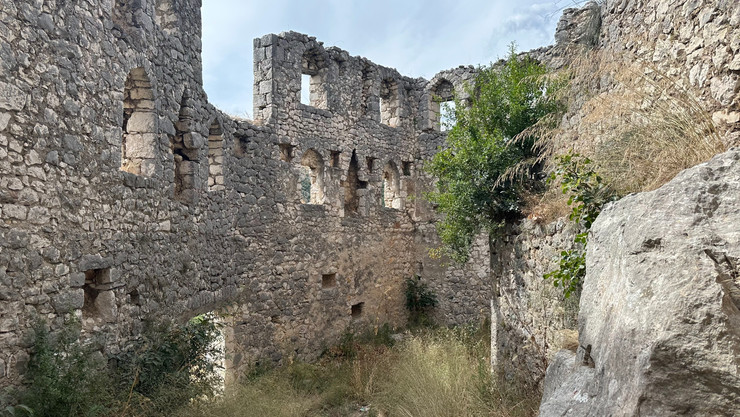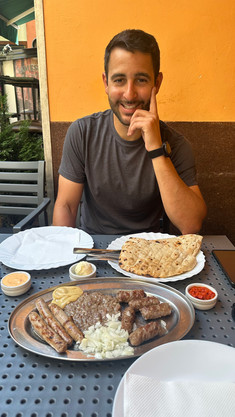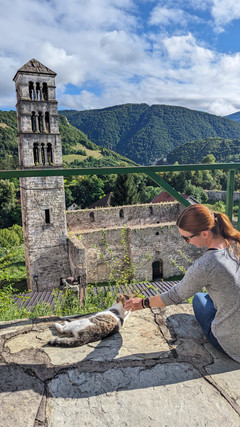After our super fast and stress-free border crossing into Bosnia and Herzegovina, we made our way to the city of Mostar just as twilight was descending on the surrounding hillsides. We ended up getting a bit of extra time to take in the setting sun as we waited almost two hours to be let in to our apartment after the person we were meeting was over an hour late and then realized he forgot to bring the apartment keys, but that is all part of traveling and we couldn’t help but laugh at the situation.
The following day we walked along the dichotomous city streets - full of so much life and beauty, but scarred with countless signs of the not-so-distant turmoil and destruction of the Bosnian War. If walls could talk, this city would have so much to say. It was chilling to see the bullet and artillery holes in buildings still in use today along with the skeletons of completely blown-out buildings and to imagine what the people of Bosnia had to endure. The war took place between 1992 and 1995, and thus many of the people you see on the streets today have their own stories to tell. A visit to the Museum of War and Genocide Victims later that week was a sobering experience (of which I will spare you the details), but we learned a lot about what humans are capable of when it comes to violence and hatred, and conversely unity and perseverance.






That afternoon, we had lunch overlooking the beautiful Stari Most, a 16th-century Ottoman bridge that was the widest arch in the world at the time of its construction. It was destroyed during the war in 1993 but rebuilt to its current state in 2004. It is now one of the most iconic views in all of Bosnia.


The following day, while walking along the cobblestone streets of the old town, we discovered that the annual bridge diving competition was happening later that day. We secured two seats down by the river’s edge and watched the brave spectacle unfold. Every summer, a few dozen people participate in a centuries-old tradition and take the 27-meter (89-foot) plunge into the cold Neretva River. A panel of judges scores both feet-first and head-first dives. Although Brian and I could not understand much of what the commentator was saying over the loudspeaker, we can now confidently count from seven to ten in Bosnian.



As if watching harrowing leaps off of bridges wasn’t enough, we decided we needed more action and went to the local mall to watch the new Mission Impossible movie that evening. One thing that we still find so strange about Europe is the number of people that smoke cigarettes. In Bosnia, however, it felt like we were transported back in time as we passed tables of people smoking indoors at the mall on our way to the movie.
The next morning, we set off on the bikes to visit the gorgeous Kravica Falls, a series of waterfalls in the southern part of the country. We took a dip in the freezing cold water, a welcome relief from the late-July heat, and people-watched on the shore. As the afternoon wore on and the crowd started to thicken, we traded our bathing suits back for our riding gear and rode to the small town of Počitelj. We walked up to the walled city and explored the ruins of this once thriving fortified town.






Later that evening, we walked back to the old town of Mostar to marvel at the illuminated bridge and buildings under the full moon.


The next day we departed Mostar en route to the capital city of Sarajevo. We passed through a stunning gorge section of the Neretva River and stopped for lunch to take in the view.




After making our way through the chaotic city traffic, we unloaded the bikes and then set out to explore the city. Sometimes referred to as the Jerusalem of Europe, Sarajevo is a truly multicultural city full of history, delicious food, friendly locals, and stunning architecture. In the same day, you can visit a mosque, a Catholic church, a synagogue, and an Orthodox church. The bustling old town is a melting pot of people in a city full of contrasts.





Similar to Mostar, however, there are ubiquitous reminders of Sarajevo’s troubled past. During the Bosnian War, Sarajevo was under siege for 1,425 days (almost four years) making it the longest siege in modern history. We learned a lot about the history of Sarajevo during a guided tour we did called The Sarajevo Roses. A Sarajevo rose is a memorial made from a concrete scar of a mortar shell’s explosion that was later filled with red paint to indicate that someone was killed from the explosion. There are around 200 “roses” throughout the city.

Our tour ended up being a private tour from a local named Mak who escaped the war with his family when he was two years old and then returned to the city when he was eight. He drove us all over Sarajevo educating us on the history of the city and its people. One of the places he took us was the Tunnel of Hope. When Sarajevo was surrounded by Bosnian Serb forces, the only link to the outside world was an 800m-long, 1m-wide tunnel between two houses on opposite sides of the airport runway. It was constructed over the course of four months by the besieged residents and provided an essential pathway for supplies to come in and people to get out.




There are so many interesting facts and intricacies about that period of time that we learned on our tour (too many to condense into a short blog post paragraph), but one of the main takeaways we learned is that Sarajevo would not have survived the siege if it were not for the residents (people from all faiths and ethnicities) coming together to defend their city as Sarajevans first and foremost. This unity, although complicated, is still obvious in the city streets, schools, and businesses of Sarajevo today. In fact, it is the only city in Bosnia where schools are integrated and no divisions are drawn across ethnic or religious lines.
One other interesting historical fact is that the Latin Bridge in the center of Sarajevo is the location where Archduke Franz Ferdinand of Austria and his wife Isabella were assassinated in 1914 creating a domino effect that ultimately led to the start of WWI. Although Sarajevo’s past is filled with conflict, its history is as rich and diverse as its people and we were grateful to catch a small glimpse of it during our time there.


Phew, okay done with the historical stuff for now.
Aside from delving into history, we spent our four days in the city relaxing, getting new off-road-oriented tires for the bikes, going to the theatre to watch Oppenheimer, interacting with the friendly locals, and trying some delicious Bosnian and Serbian foods including ćevapi, a minced meat sausage typically served with a warm, pita-like bread. This was our first time in Sarajevo, but I think we can both agree it won’t be our last.
Our next stop was the small town of Jajce, a prosperous town during the medieval times located in central Bosnia. After stopping for lunch in the town of Travnik, riding through a rain storm up to the top of Mount Galica, and testing out our new off-road tires on some dirt, we arrived to Jajce just as the clouds began to part and the sun came out. We spent the evening exploring the medieval fortress, admiring the Pliva Waterfall in the center of town, people watching in the main square, and making friends with the cutest and friendliest stray cat I have ever met (whom I named Strudel).





The next day we headed south toward the border with Montenegro. We stopped for lunch along the beautiful Neretva River again and decided we couldn’t leave Bosnia without trying some of the famous Bosnian coffee. Similar in taste to Turkish coffee, Bosnian coffee is a strong, unfiltered coffee served in an elegant copper pot. After observing locals (and watching a short YouTube video), we learned that the traditional way to drink it is by taking a small bite of a sugar cube before every sip. While neither of us was too fond of the coffee itself, we enjoyed the experience - and the subsequent sugar high.


It is a good thing we were caffeinated, because later on in the afternoon a large storm rolled in causing us to change our route last minute. Rather than ride up a high mountain pass in the middle of the formidable-looking storm, we opted to follow Google Maps’ alternative route - one that quickly turned into 30 km of thick gravel, deep ruts, and mud.




Despite having all of our luggage, we both managed to make it through with only a few curse words and no bike drops! And although the terrain was steep and challenging at times, it ended up being a lot of fun and probably good practice for the roads to come. The route did eventually join up with a main road and then we wound our way through the golden sunlit countryside into the town of Foča. This town is located in the Bosnian-Serb controlled territory and it definitely felt like another country. All of the road signs were written in Cyrillic and it was strange to see Russian flags hanging on many buildings along with murals and statues of people convicted of war crimes. Its proximity to the Montenegro border, however, made it the perfect stopping point to set us up for the next day.
The following morning, Brian woke up not feeling well. We would soon find out that the grocery store restaurant we ate at the previous night (where Brian decided to try a local cuisine of chicken, ham, and cheese wrapped in bacon) was not a good choice. Unfortunately, the apartment we stayed in was not available for another night so Brian took some medicine and we decided to push on.
The border crossing was fast and simple and before we knew it we were in Montenegro! We rode through a canyon along a bright blue reservoir before beginning the steep ascent up a winding, narrow mountain road. We stopped at the top to take in the views.




We continued down the road and soon approached the start of Durmitor National Park. As we made our way farther into the park, we marveled at the towering limestone peaks and rolling hills of green and golden yellow grass. Brian had actually ridden through Durmitor seven years prior on a shorter motorcycle trip, but we were both excited to spend some time really exploring the area. Since Brian still wasn’t feeling well, however, we found an apartment in the small town of Žabljak and spent the evening and the following day relaxing.






After a day mostly indoors, we were anxious to get out and explore. We embarked on a loop ride along one of the panoramic roads that traverse the park. The route gave us a peak into Europe’s deepest canyon (and the second deepest canyon in the world), the Tara Canyon, before winding us through lush forests on a precariously narrow two-way road through the trees and back out into the expansive valley surrounded by limestone massifs. There was something so magical about the way the light hit the unique rock striations and we stopped frequently to take in the scenery.









The next day we set off early to explore the mountains on foot. The majority of people who go to Durmitor end up climbing its highest peak, Bobotov Kuk. Although the hike was tempting (in both its fun name and challenging nature), we decided it probably wasn’t the best idea since Brian was still recovering from his stomach bug. Instead, we opted to do a slightly easier and lesser-traveled hike up the gorgeous Prutaš Peak. The views of the glacial striations in the mountainside and surrounding peaks were mesmerizing.








We stopped for lunch overlooking the Skrka Valley with its two bright blue lakes and made an adorable canine friend who became our hiking buddy for part of the way down the mountain.


We left Žabljak the following morning and headed for the Adriatic coast. The scenery and the temperature dramatically changed as we dropped toward the sea.


We found a hotel on the outskirts of a bustling beach town called Budva before making the short ride north to the city of Kotor. Kotor is a beautiful medieval walled town complete with a fortress overlooking the bay. The sun was just beginning to set when we arrived, so we raced through the cobblestone streets and up the 1,350 steps to catch the sunset from the top of the fortress. Although we looked like we had just fallen into a pool from the amount of sweat on our clothes, the views were well worth the effort as we made it to the top in time to watch the last rays of light crawl up the mountainside as the sky transformed from a light blue to a glowing orange.











We slowly made our way back down the steps in search of a place to get dinner. Our plan had been to eat and then head back to our hotel to go to bed and get an early start the following morning, but Kotor had other plans for us. It turned out that we were there for the culminating night of their biggest festival of the year - Karneval. By the time we finished eating, the entire main street was flooded with people in costumes dancing, singing, and lining up to catch the huge parade that was about to begin; a parade that gave our bikes front row seats to the action and blocked the exit out of the city. We had no other choice but to join in on the festivities! The energy of the crowd was contagious as we marveled at the performers and then walked the lively city streets until midnight when the road re-opened.


After a good night’s rest, we rode back into the city the following afternoon to take in the stunning architecture and make friends with some of Kotor’s friendliest residents - the cats. No visit to Kotor is complete without petting some of these feline friends and there is even an entire museum dedicated to cats in the old town. Cats were introduced to the city a long time ago to help lower the rodent population in the port and they are seen today as a symbol of good luck. Brian was patient as I made sure to pet and cuddle every adorable cat and kitten in sight! Anyone who knows me can understand why Kotor is now one of my favorite cities and I will definitely be back one day.







^ Watching this giant cruise ship dock was wild

That evening, we rode into downtown Budva for dinner. Budva, known for its beautiful beaches and happening nightlife, reminded us a lot of South Beach in Miami. We enjoyed walking around the old town and along the shore, but decided the crazy traffic and party scene were not quite our style.



The next morning we rode a three-hour loop that took us up the famous winding Serpentine road out of Kotor, through Lovćen National Park, and into the old capital of Montenegro - Cetinje. We stopped for lunch in Cetinje for one of my favorite go-to meals in the Balkans: Goulash.


Exhausted and sweaty from the afternoon heat, we spent the second half of the day relaxing in the cool Adriatic water of Jaz Beach. We managed to walk far enough down the shore (away from the paid umbrellas, restaurants, and loud music) to find this little slice of coast and stayed until the sun disappeared behind the mountains.




We really enjoyed our time in Montenegro and could have easily spent more time there, but the next day we took the busy but beautiful coastal road across the border into Albania.

Cheers,
Brian and Erin




















































Comments